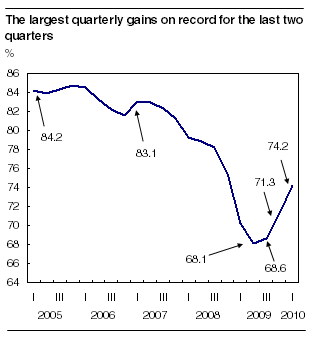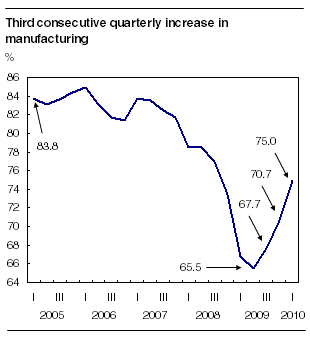Canadian industries operated at 74.2 percent of their production capacity in the first quarter of 2010, up from 71.3% in the fourth quarter of 2009, Statistics Canada reported on June 11. This was the third consecutive quarterly increase.

Prior to these gains, capacity use had been on a downward trend since the first quarter of 2007, when the rate was 83.1%, 8.9 percentage points higher than the rate in the first quarter of 2010.
Increases of 2.7 percentage points in the fourth quarter of 2009 and 2.9 percentage points in the first quarter of 2010 were the largest quarterly gains on record.
The strength recorded by the overall Canadian industries was mainly driven by the manufacturing industry, where the utilization rate rose from 70.7% to 75.0%.
Most non-manufacturing sectors posted gains in capacity use for a second consecutive quarter. In the first quarter of 2010, mining led the growth with an advance of 8.2 percentage points.
Growth in capacity use in manufacturing widespread
Growth of capacity use in manufacturing was widespread, with 20 of the 21 major manufacturing industries advancing.
Capacity use in total manufacturing increased by 4.3 percentage points in the first quarter of 2010 to 75.0%, following gains of 3.0 and 2.2 percentage points in the fourth and third quarters of 2009, respectively.

Overall, four industries were major contributors to the higher rate for total manufacturing: transportation equipment, primary metal, chemical, and machinery manufacturing.
Note to readers
The industrial capacity utilization rate is the ratio of an industry's actual output to its estimated potential output. The measures of actual output used in the production of the rates of capacity use are the measures of real gross domestic product at factor cost, seasonally adjusted, by industry.
With this release, rates have been revised back to the first quarter of 2008 to reflect the revised source data.
The transportation equipment industry operated at 63.6% capacity in the first quarter of 2010, compared with 60.0% in the previous quarter. This was 16.3 percentage points higher than the first quarter of 2009, when the industry's capacity use hit the lowest level on record. Manufacturers of motor vehicles and motor vehicle parts continued to increase production in response to sustained demand for automotive products in both Canada and the United States.
In the primary metal manufacturing industry, the utilization rate rose 9.5 percentage points in the first quarter of 2010 to 86.4%, following another 9.5 percentage point increase in the fourth quarter of 2009. Production of primary metals was up 8.8%, the result of increased iron and steel mills and ferro-alloy production, and alumina and aluminum production and processing.
Capacity use in the chemical manufacturing industry grew from 76.7% to 82.1%, continuing an upward trend that started in the third quarter of 2009. Higher production by pharmaceutical and medicine manufacturers and by petrochemical manufacturers led to a 4.2% production gain in the industry.
Machinery manufacturers used 71.6% of their production capacity, up from 64.8% in the previous quarter. The main contributing factor was a large increase in the production by metalworking machinery manufacturers, and by construction, mining and oil and gas machinery manufacturers.
Printing and related support activities was the only industry among the 21 major manufacturing industries to post a lower first quarter rate. Capacity use in the industry edged down from 63.9% to 63.7%, reflecting a 0.4% reduction in output. This industry had among the lowest utilization rates in manufacturing. Clothing had the lowest rate at 57.2%, 13.0 percentage points lower than in the first quarter of 2009.
Non-manufacturing: Capacity use continues to rise in most sectors
In the non-manufacturing group, capacity use advanced in the mining, construction and forestry and logging sectors. The oil and gas extraction sector used less of its production capacity while the utilization rate of the electric power generation, transmission and distribution sector remained unchanged.
In mining, capacity use rose from 58.0% to 66.2% in the first quarter, following an increase of 7.5 percentage points in the previous quarter. This increase reflects a 14.3% advance in production, largely attributable to substantial output gains in support activities and potash mining.
Capacity use in the construction sector increased from 70.2% to 71.8%, as production in residential construction rose 8.2%.
The oil and gas extraction sector reduced its capacity use by 0.8 percentage points to 76.2% in the first quarter. This reduction was driven mainly by lower crude petroleum extraction activity, which offset higher activity in natural gas facilities.
In the electric power generation, transmission and distribution sector, the utilization rate remained unchanged at 78.4% from the fourth quarter of 2009. Demand for electricity was flat in the first quarter of 2010.
Available on CANSIM: table 028-0002.
Definitions, data sources and methods: survey number 2821.
Data on industrial capacity utilization rates for the second quarter of 2010 will be released on September 14.
For more information, or to enquire about the concepts, methods or data quality of this release, contact Xiang Zhou (613-951-0457; xiang.zhou@statcan.gc.ca), Investment and Capital Stock Division.




